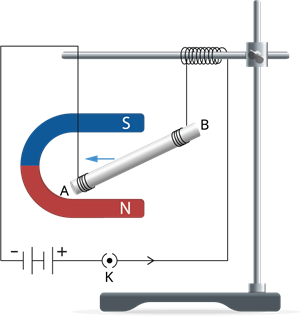
PUMPA - SMART LEARNING
எங்கள் ஆசிரியர்களுடன் 1-ஆன்-1 ஆலோசனை நேரத்தைப் பெறுங்கள். டாப்பர் ஆவதற்கு நாங்கள் பயிற்சி அளிப்போம்
Book Free DemoWe have seen that an electric current flowing through a conductor creates a magnetic field. The created field exerts a force on a magnet placed in the region of the conductor.
Andre Marie Ampere (\(1775–1836\)), a french scientist, found that the magnet employs an equal and opposite force on the current-carrying conductor.
The following activity demonstrates the force due to a magnetic field acting on a current-carrying conductor.
Steps:
- Take a small aluminium rod of about \(5\)cm and name its ends as A and B. Using two connecting wires, hang it horizontally from a stand, as shown in the below figure.

A current-carrying rod
- Locate a strong horseshoe magnet so that the rod rests between the two poles with the magnetic field directed upwards. For this, put the magnet's north pole vertically below and the south pole vertically above the aluminium rod (as shown in the figure).
- The aluminium rod, battery, key and rheostat are connected in series (as shown in the figure).
- Now allow a current flow through the aluminium rod from end B to end A.
What do you see?
It is seen that the rod is relocated towards the left. You will see that the rod gets relocated.
- Reverse the direction of current flowing through the rod (end A to B) and notice the direction of its displacement.
The rod is now relocated towards the right.
Why does the rod get displaced?
The displacement of the aluminium rod suggests that a force is exerted on the current-carrying conductor when it is placed in a magnetic field. It also shows that when the direction of the current through the conductor is reversed, the direction of force is also reversed.